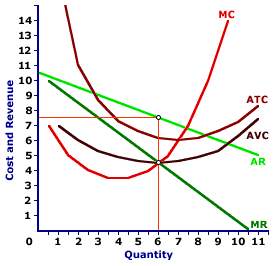
|
|
PHYSICAL SCIENCE: The scientific study of nonhuman, nonsociety phenomenon, such as atoms, planets, wildlife, and continental drift. Common disciplines that study these physical phenomenon go by the names physics, chemistry, biology, geology, and astronomy, among others. The primary reason for this entry is to provide a contrast with social sciences, especially economics, that study human behavior and society.
Visit the GLOSS*arama
|
|


|

|
                           MONOPOLY, EFFICIENCY: A monopoly generally produces less output and chargers a higher price than would be the case for perfect competition. In particular, the price charged by a monopoly is higher than the marginal cost of production, which violates the efficiency condition that price equals marginal cost. Monopoly is inefficient because it has market control and faces a negatively-sloped demand curve. Monopoly does not efficiently allocate resources. In fact, monopoly (if left unregulated) is generally considered the most inefficient of the four market structures. The reason for this inefficiency is found with market control. As the only seller in the market, the negatively-sloped market demand curve is THE demand curve facing the monopoly. If buyers want to buy, they must buy from the monopoly.The negative slope of the demand curve means that the price charged by the monopoly is greater than marginal revenue. As a profit-maximizing firm that equates marginal revenue with marginal cost, the price charged by monopoly is greater than marginal cost. The inequality between price and marginal cost is what makes monopoly inefficient. Profit Maximization| Inefficiency |  |
Consider the production and sale of Amblathan-Plus, the only cure for the deadly (but hypothetical) foot ailment known as amblathanitis. This drug is produced by the noted monopoly firm, Feet-First Pharmaceutical.A typical profit-maximizing output determination using the marginal revenue and marginal cost approach is presented in this diagram. Feet-First Pharmaceutical maximizes profit by producing output that equates marginal revenue and marginal cost, which is 6 ounces of Amblathan-Plus in this example. The corresponding price charged is $7.50. This profit-maximizing production is not efficient. In particular, the price is $7.50, but the marginal cost is only $4.50. Society is producing and consuming a good that it values at $7.50 (the price). However, in so doing, society is using resources that could have produced other goods valued at $4.50 (the marginal OPPORTUNITY cost). Society gives up $4.50 worth of value and receives $7.50. This is a good thing. It is so good, that society should do more. However, the monopoly is not letting this happen. Feet-First Pharmaceutical is not devoting as many resources to the production of Amblathan-Plus as society would like. An Efficient AlternativeThe degree of monopoly inefficiency can be illustrated with a comparison to perfect competition. Such a comparison is easily accomplished by clicking the [Perfect Competition] button. A primary use of perfect competition is to provide a benchmark for the comparison with other market structures, such as monopoly.A comparison between monopoly and perfect competition indicates: - Monopoly produces less output than perfect competition. In this example, monopoly produces 6 ounces of Amblathan-Plus compared to about 7.5 ounces for perfect competition. The Feet-First Pharmaceutical monopoly does not allocate enough resources to the production of Amblathan-Plus.
- Monopoly charges a higher price than perfect competition. In this example, the monopoly price is $7.50 per ounce versus about $6.75 per ounce for perfect competition. The Feet-First Pharmaceutical monopoly is NOT efficient because it produces at a quantity in which price is greater than marginal cost.

Recommended Citation:MONOPOLY, EFFICIENCY, AmosWEB Encyclonomic WEB*pedia, http://www.AmosWEB.com, AmosWEB LLC, 2000-2025. [Accessed: July 18, 2025].
Check Out These Related Terms... | | | | | | | |
Or For A Little Background... | | | | | | | | | | |
And For Further Study... | | | | | | |
Search Again?
Back to the WEB*pedia
|



|

|
BLACK DISMALAPOD
[What's This?]
Today, you are likely to spend a great deal of time browsing about a thrift store seeking to buy either a genuine fake plastic Tiffany lamp or a microwave over that won't burn your popcorn. Be on the lookout for small children selling products door-to-door.
Your Complete Scope
This isn't me! What am I?
|

|
|
The penny is the only coin minted by the U.S. government in which the "face" on the head looks to the right. All others face left.
|

|
|
"A winner is someone who recognizes his God-given talents, works his tail off to develop them into skills, and uses those skills to accomplish his goals. " -- Larry Bird, basketball player
|

|
BACS
Bankers Automated Clearing Services
|

|
|
Tell us what you think about AmosWEB. Like what you see? Have suggestions for improvements? Let us know. Click the User Feedback link.
User Feedback
|


|


